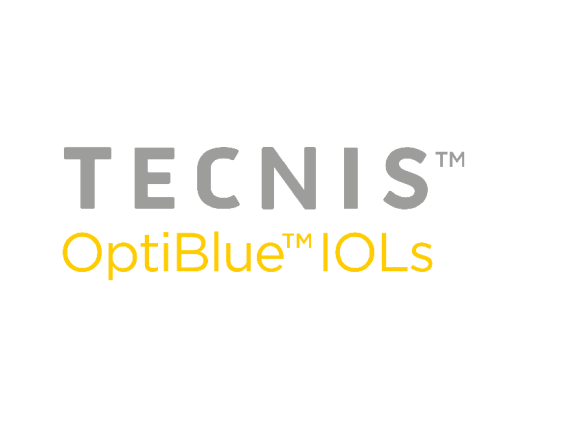TECNISTM OptiBlueTM 1-Piece IOL
TECNISTM OptiBlueTM 1-Piece IOL
To order this product, please contact your sales rep.
The filter that leaves patients able to benefit from blue light
TECNIS™ OptiBlue™ Yellow Aspheric IOL is the filter lens with TECNIS™ IOL technology for high-quality outcomes.1-5
The yellow lens with a violet-light filter allows full transmission of healthy blue light:
- Blue light is critical in controlling circadian rhythms6
- 35% of scotopic vision sensitivity depends on blue light6
Full transmission of blue light and consistent light transmittance with
TECNIS™ OptiBlue™ IOL7

Improved melanopsin sensitivity, which influences circadian rhythms that may play a role in sleep pattern, mood, memory, and systemic health.6
Increased Scotopic Sensitivity Increased Melanopsin Sensitivity
With TECNIS™ OptiBlue™ IOL*8 With TECNIS™ OptiBlue™ IOL*8

* Adapted from Mainster MA. Violet and blue light blocking intraocular lenses: photoprotection versus photoreception. Br J Ophthalmol. 2006;90:784-792. REF2014MLT0026.
Unlike another leading IOL, TECNIS™ IOL material is not associated with glistenings,1,9-12 which can inhibit your patients’ vision. Glistenings cause light scatter, which can result in a reduction in image contrast.9-13
|
Model: |
ZCB00V |
|
|
OPTIC CHARACTERISTICS2 |
||
|
Powers: |
+5.0 D to 34.0 D in 0.5 diopter increments |
|
|
Diameter: |
6.0 mm |
|
|
Shape: |
Biconvex, anterior aspheric surface, square optic edge |
|
|
Material: |
Soft foldable hydrophobic acrylic with UVAM and violet light-filtering chromophore* |
|
|
Refractive Index: |
1.47 at 35° C |
|
|
Edge Design: |
ProTEC frosted, continuous 360° posterior square edge |
|
|
BIOMETRY |
APPLANATION ULTRASOUND |
OPTICAL‡ |
|
A-Constant: |
118.8§ |
119.3** |
|
Theoretical AC Depth: |
5.4 mm |
5.7 mm |
|
Surgeon Factor:14 |
1.68 mm |
1.96 mm |
|
HAPTIC CHARACTERISTICS2 |
||
|
Overall Diameter: |
13.0 mm |
|
|
Configuration: |
Tri-Fix design, modified C, integral with optic, one-piece lens |
|
|
Material: |
Soft foldable hydrophobic acrylic with UVAM and violet light-filtering chromophore* |
|
|
Design: |
Haptics offset from optic |
|
IOL INSERTION
Recommended insertion instruments:
The UNFOLDERTM Platinum 1 Series Implantation System: Intuitive push-and-twist, screw-style insertion designed to simplify lens implantation.
Also available preloaded in TECNIS SimplicityTM Delivery System.
FOOTNOTES
*The lens has a yellow hue, and upon slit lamp examination a slight blue appearance can be detected off the anterior surface.** Based on average pseudophakic human eye and ‘Holladay et al. A three-part system for refining intraocular lens power calculations. J Cataract Refract Surg. 1988;14(1):17-24. REF2014CT0092.
‡ Derived from clinical evaluation results of the TECNIS™ 1-Piece IOL Platform for optical biometry.
§ A-Constant theoretically derived for ultrasound biometry.
REFERENCES
1. Data on file 150 – SENSAR™ not associated with glistenings - Literature analysis. REF2014OTH0002.
2. TECNIS™ OptiBlue™ 1-Piece IOL, Model ZCB00V DfU INT – Z311737P, current revision.
3. Zhao H, Piers PA, Mainster MA. The additive effects of different optical design elements contributing to contrast loss in pseudophakic eyes implanted with different aspheric IOLs. Presented at: 27th Congress of the ESCRS; 2009 Sep 4–8; Barcelona, Spain. REF2014MLT0020.
4. Terwee T, van der Mooren M, Piers P. Optical performance of TECNIS™ IOLs compared with IOLs that partly compensate for the mean SA of the human cornea. Presented at: Annual Meeting of the American Society of Cataract and Refractive Surgery; 2008 Apr 4–9; Chicago. REF2014MLT0019.
5. Nixon DR. Pattern of posterior capsule opacification models 2 years postoperatively with 2 single-piece acrylic intraocular lenses. J Cataract Refract Surg. 2010; 36:929-934. REF20140020.
6. Mainster MA. Violet and blue light blocking intraocular lenses: photoprotection versus photoreception. Br J Ophthalmol. 2006;90:784-792. REF2014MLT0013.
7. Data on file 180 – TECNIS™ OptiBlue™ IOL, Model ZCB00V Transmission Spectrum. Dec 2, 2012. DOF2015CT0019.
8. Data adapted from Mainster MA. Violet and blue light blocking intraocular lenses: photoprotection versus photoreception. Br J Ophthalmol. 2006;90:784-792. REF2014MLT0026.
9. Nagata M, et al. Clinical evaluation of the transparency of hydrophobic acrylic intraocular lens optics. J Cataract Refract Surg. 2010;36(12):2056-2060. REF2015CT0080.
10. Christiansen G, et al. Glistenings in the AcrySof® intraocular lens: Pilot study. J Cataract Refract Surg. 2001;27(5):728-733. REF2014MLT0005.
11. Colin J, et al. Incidence of glistenings with the latest generation of yellow-tinted hydrophobic acrylic intraocular lenses. J Cataract Refract Surg. 2012;38(7):1140-1146. REF2014MLT0006
12. Gunenc U, et al. Effects on visual function of glistenings and folding marks in AcrySof® intraocular lenses. J Cataract Refract Surg. 2001;27(10):1611-1614. REF2014MLT0011.
13. Van der Mooren M, Franssen L, Piers P. Effects of glistenings in intraocular lenses. Biomed Opt Express. 2013;4(8):1294-1304. REF2014OTH0139.
14. Holladay JT. International Intraocular Lens & Implants registry 2003. J Cataract Refract Surg. 2003;29:176-197. REF2016CT0151.
© Johnson & Johnson and its affiliates 2024
For healthcare professionals only. Please reference the Instructions for Use for a complete list of Indications and Important Safety Information and contact our specialists in case of any question.
2024PP14294

